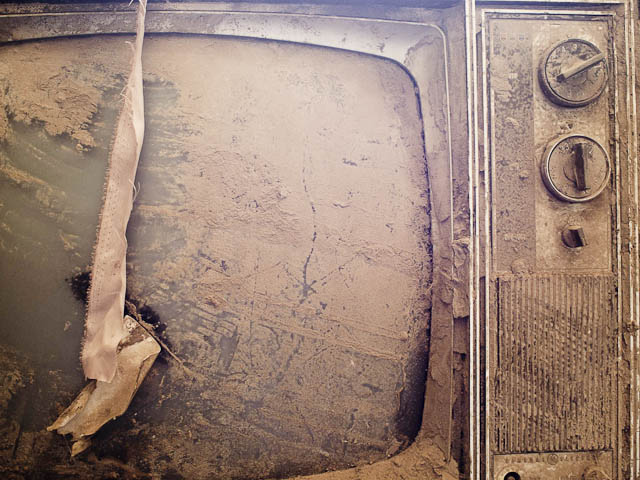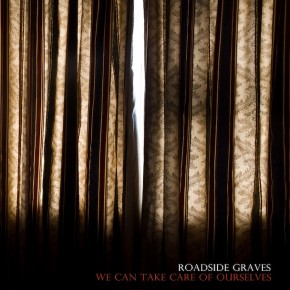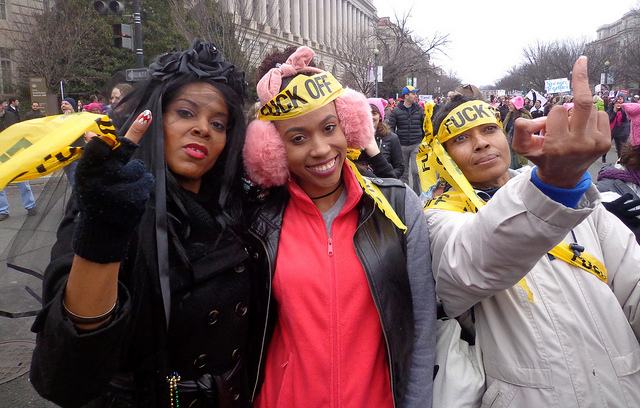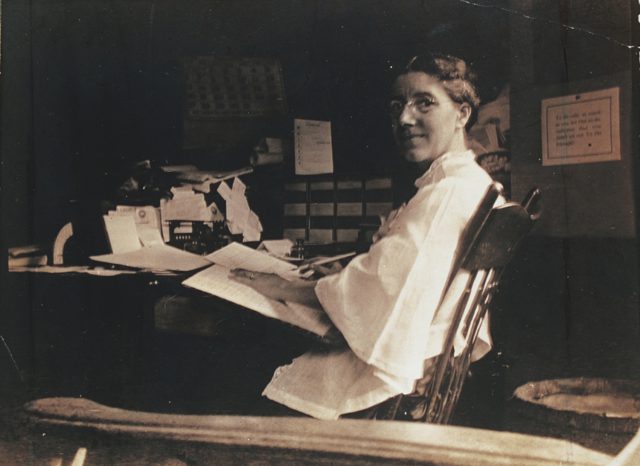Television sets: almost every house has one. When we’re out in the mining towns of southern Arizona photographing the wreckage of the American Dream, there are some things that we always find. Refrigerators, beds, stoves, sofas, clothing, knickknacks, pots and pans sit in the abandoned houses scattered across the Copper Belt, ghosts of a domestic life once lived and now long gone. Then, sitting somewhere in the corner of a room, in a closet, or on a porch is the abandoned television set.
Small sets with metal antennae sticking out of the top like deaf ears. Console TVs wearing their ornate pressed wood bodies like some kind of outdated formal suit that had been worn to convey past economic status, the laurels earned through hard labor and cold cash or credit. Giant big-screen TVs from the 1980s stand impotent and coated with dust, artifacts from the time when the expansion of global labor markets would eventually lead to gutting the very homes where they have come to rest.
Since the 1950s when the television set became a commonplace household item, owning one was an emblem of the American Dream. Many Americans were lead to believe that home ownership and television were synonymous with democracy and freedom. While the State controlled all content on Soviet television, in America the fantasy of freedom and success was delivered without interruption through commercial TV programs.
These shows idealized American life and provided a glistening model where economic purchases brought happiness and success, and the commercials told you which products to buy in order to fulfill the dream. Television programming in America had to put a smiling face on capitalism to sell the products that funded it. It had to be supported by a sanctified view of democracy. Television was the perfect ideology delivery system. In fact, 1950s television programming was so idealistic in its vision of American democratic life that it mimicked the heavy-handed Soviet propaganda so derided by the Western press; both shared the same goals — promoting political ideology — but through different control mechanisms.
A TV in the living room of your own home became the sign of economic stability, proof that American democracy was alive and well, that capitalism works and that under it you can provide for your family and create a happy home: all you have to do is work hard and believe in the American dream. Televisions have stood in living rooms across the country as totems to this dream. TV became the soundtrack of American life. People spent all day at work, came home, and turned on the TV. Inside that box, they found proof that their hard work paid off, but they also found escape from the workaday world they left behind when they punched the clock and headed home.
In small isolated mining towns, like the ones we photograph, such as Safford, Clifton, Winkelman and Miami, television can provide a substitute for life and an escape from the brutality of working in the open pit mines. The television screen brings scenes of an imaginary world into the homes of working-class people that is far removed from the bleak, toxic and dangerous landscape of these rural communities.
TV doesn’t just provide escape, but it also creates an alternative life, a simulated world that includes a whole cast of “friends and family” being broadcast through network programming. Life as broadcast on TV can substitute for actual life when the life lived doesn’t have many opportunities, economic or otherwise. TV can become a social world of its own, especially when the social world is limited to a few local bars and a Walmart. People can lose themselves inside television shows as they relate to the cast of characters in sitcoms and dramas as if they were real people. People care about what happens to the characters in the shows they watch. They know the characters’ names and histories. They relate to them as if they are real friends and family.
Integrating TV shows, characters, and stories into their own lives doesn’t just provide people with escape, but also provides a connective tissue through media and a common social discourse removed from the realities of their hard working life. TV shows provide their own kind of social forum when the opportunities of socializing are limited.
Originally TV was a sign of economic success — a status symbol — but it quickly became a necessity for participating in American life as lived by the masses. Being unfamiliar with the characters in the newest hot sitcom could put you at a social disadvantage. When everyone at the work lunch table was discussing the various dramas from last night’s TV shows, you’d be left outside the circle if you didn’t watch them also.
At some point, the lives of pretend characters can seem more important than the lives of friends and family members, especially in hard times when the realities of real life include mass job layoffs, meth addiction, alcoholism and domestic violence. Being able to discuss TV characters and their humorously messed-up lives provides an outlet for momentarily escaping the hard-luck reality of many working-class families struggling to pay their cable bills and wondering if they will still have their job next month.
Economic instability has been a fact of life in the Copper Belt since the early 1980s when Reaganomics began outsourcing jobs, breaking labor unions, and displacing many of the towns’ inhabitants, for whom mining was often the sole source of employment. What happens when the domestic world of these working-class towns is turned upside down, when the labor force in the mines is reduced exponentially, and when foreclosure moves in and families move out?
When mines make large labor cuts in an area that is only supported by that single industry, people must leave to find work. Many unemployed workers lose their houses to foreclosure. They leave their homes and their higher-paying union jobs for low-paying, non-union jobs in other cities and towns. They walk away leaving their houses, their refrigerators and their old TVs.
The houses scattered in large number across the Copper Belt are evidence of the global economy that has led to rampant foreclosures and unemployment. They are evidence of the basic flaw equating the fantasy of the American Dream — propaganda for democracy and capitalism — with the ability to own a home. In reality, almost no one actually owns their home. Houses are highly leveraged investments that carry high personal risk. In fact banks, not people, own most houses in the United States.
But banks don’t live in working-class houses. When the homes are taken over through foreclosure, they are left unoccupied. The only thing residing in these houses are those old refrigerators, stoves and dead TVs that no one wants to buy. Reality comes down hard, and all those “friends and family members” on the TV are gone with a single pull of the plug and a notice from the bank. There are no television shows about the gutted houses of the Arizona Copper Belt where jobs have been sent to mines in Indonesia and Brazil, and families have been uprooted and forced to leave their homes, including their televisions, behind.
TV offers a view where the world is delivered in two-minute segments on the five o’clock news, where the harsh truths of the global economy are subverted by sports, weather, and the latest local emotional teaser, anything that will keep you watching the news and distract you from the real story. There’s not much room for the reality of the disenfranchised worker. Their lives are delivered in statistics and numbers, lumped into the overall unemployment rate. We don’t see the TVs they left behind being broadcast on the TVs that are plugged into living rooms. That would be too much reality. TV’s job is to deliver a sense of reality while providing escape from the real thing. Dead TVs and what they stand for in the Copper Belt don’t fit into this picture.
No, there aren’t any TV shows depicting the lives of copper miners. But even if there were, TV’s portrayal of that life would be so far removed from reality that few miners would probably be able to watch it. The clash between TV fantasy and the reality of life as a miner would be too much to stomach. Instead more universal sitcoms like Roseanne became popular depictions of working-class life. Roseanne was first broadcast in 1988, seven years into the Reagan presidency, after the economic assault on the working class — which eventually led to today’s massive unemployment and foreclosure rates — was well underway.
In shows like Roseanne, the characters portrayed are obviously working class, but they provide an idealized and/or parodic model of its reality. This model provides the working class with a source of identification coated with a veneer of jovial humor to maintain safe distance from their own reality. However, this model also uses the working class as a source of humor and entertainment for those who are not working class. In other words, in the form of true capitalist exploitation, shows like Roseanne use the working class to have their cake and eat it too.
In the meanwhile, every working household is affected by world events. The world economy is what makes jobs in mining towns disappear. It is what makes the technology in old TVs as obsolete as the kind of labor that once made towns like Clifton boom. In these towns, the bodies of dead TVs stand on porches, in backyards and empty living rooms like the bodies of the gutted workers and the defunct American Dream that left them bankrupt and homeless. These outdated TVs with their cathode ray tubes bulging from their dead bodies are like ghosts from the era of Reaganomics when the global market began cannibalizing the working class, rendering its jobs, television sets, and the American Myth obsolete.
As manufacturing shifted to Asia and other cheap labor markets, media technology advanced at a breakneck speed. It enticed people to want the newest television set even when their jobs were on the line and their TV, like their job, would soon be replaced by the newest products from overseas. New media technology has allowed the global market to carnivorously devour the American workforce. In fact, television production itself was largely outsourced to cheap Asian factories. As working class Americans, such as the miners in the copper belt, sat on their sofas watching their new Sony television sets, it was sort of like eating from the very beast that would eventually consume them.
Global capitalism’s voracious appetite for creating new products while destroying stable working-class jobs makes people and commodities both disposable. Old worthless TVs are left where they stand while workers are kicked to the curb. Congress mandated that June 12, 2009 would be the last day for analog TV transmissions in the U.S. After this date everyone either had to upgrade to a new digital TV or acquire an analog-to-digital conversion box with appropriate antennae. Otherwise, they’d be left with a dead TV and nothing to watch but the life around them.
When you are living day-to-day with the threat of unemployment hanging over your head, it can be hard to respond to complications in your basic life. When most CRT televisions were rendered obsolete overnight, it had to have been heartbreaking to find that hard-earned money had been thrown away on a dead box of electronic circuits or, worse yet, to have to continue to pay credit-card bills to big banks each month for a television set that wasn’t worth a cent.
Yes, there were notices from the broadcasters. Yes, there was plenty of warning that the days of the cathode ray analog TV was over. But when you’re working double shifts and struggling to make ends meet, it’s hard to find the time or money to be ready for the new technology. Many people felt stuck with large, heavy and expensive commodities now rendered almost useless. These dead TVs stand as icons of the new waste economy, where people and televisions are equally disposable.
Of course, the world economy would not function without copper. No one would be watching TV without copper. Power and signal delivery both require massive amounts of copper. Without copper, the mechanisms that drive the global market could not exist. Copper is the life blood of the worldwide communication grid.
As the market demands more copper to feed the economy, mining production has increased in southern Arizona and jobs are booming again. But the damage has been done. Dead TVs still litter porches and living rooms of abandoned homes as miners drive into town and stay in motels for the work week. They get their dose of TV from a box locked down to a cheap press-board dresser. After losing their jobs and their homes, they’ve learned to take work one day at a time and not trust a system that is going to kick them out the door when they’re no longer needed. They’ve learned first hand what it feels like when the American dream fails and people and their dead TVs are left behind.















We had Black and White TV’s in the 60-70’s when the switch failed to work to turn on the TV a service man suggested a clapper type switch turning it on via the plug with a switch on top of the set it was an admiral TV with the pressed wood body to which you refer those times were rife with the economic terms you also site. After the death of that one our family purchased one of the new “Portable” models a 20 inch with a credit purchase plan to be set on top of the old TV for 10 years or so friends in those years would come over to watch programs on a TV set on a TV that was DEAD what a metaphor for that time you awakened thanks for this.
This was linked from Counterpunch.org. You wrote in part, “Congress mandated that June 12, 2009 would be the last day for analog TV transmissions in the U.S. After this date everyone either had to upgrade to a new digital TV or acquire an analog-to-digital conversion box with appropriate antennae. Otherwise, they’d be left with a dead TV and nothing to watch…” I hope you recall that the Federal government offered $40 coupons to help people buy Digital to Analog (not vice-versa) converter boxes, which typically retailed from $50 to $80. Thus the net cost was relatively small, although there were sometimes issues with antennas. Also, most cable companies still offer some analog cable channels along with digital choices. We have over 70 analog cable channels here east of Cleveland, Ohio. Most analog TVs built from the mid-1980’s through 2009 have tuners compatible with analog cable. You exaggerate the issues to support your artsy photographic montage.
I sent for the discount card and it was sent to me via USPS and went to get convertor box they were out of them then when they were in stock I went to get them (2 cards were sent) it was discovered that the cards were expired . I was unable to get more because LIMIT 2 and the program had also expired. Lastly this was not an essay about TV’s. As in 1992 Clinton presidential run put it ” Its the Economy”.
I put in for one of those coupons. It never arrived. I think they ran out or something. I’ve got 4 TVs in the house, most people have more than two. It would only have been a partial solution anyway. Didn’t seem like that big a deal at the time but now that I’m contemplating cutting cable the cost of 3 converters and 3 high quality antenna’s (one of my TV’s is digital) puts a damper on those plans.
Interesting article, but you failed to mention the Government Coupon program which allowed you to basically obtain a DTV converter for free. I received my coupon which allowed me to purchase a DTV converter and continue to use my 20+ year old Magnavox. With regards to the antenna, if you were able to pick up UHF analog signals, you more than likely have the correct antenna to pick up DTV.
Did all the workers who had good paying jobs who lost them through “free trade get their government coupon ?
i enjoyed your take on roseanne ,she’s running for president. recently on democracy now she dismissed class interests and emphasized race and gender. sad.but it dovetails well with your analysis.